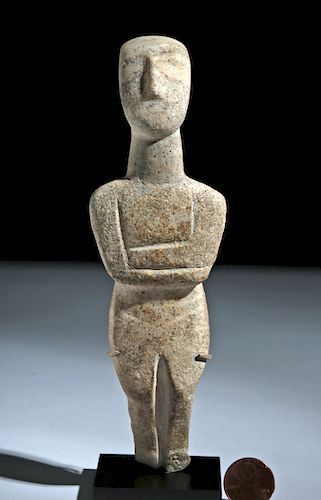Greek Cycladic Marble Figure of the Spedos Type
Lot 8a
About Seller
Artemis Fine Arts
686 S Taylor Ave, Ste 106
Louisville, CO 80027
United States
Selling antiquities, ancient and ethnographic art online since 1993, Artemis Gallery specializes in Classical Antiquities (Egyptian, Greek, Roman, Near Eastern), Asian, Pre-Columbian, African / Tribal / Oceanographic art. Our extensive inventory includes pottery, stone, metal, wood, glass and textil...Read more
Estimate:
$100,000 - $150,000
Absentee vs Live bid
Two ways to bid:
- Leave a max absentee bid and the platform will bid on your behalf up to your maximum bid during the live auction.
- Bid live during the auction and your bids will be submitted real-time to the auctioneer.
Bid Increments
| Price | Bid Increment |
|---|---|
| $0 | $25 |
| $300 | $50 |
| $1,000 | $100 |
| $2,000 | $250 |
| $5,000 | $500 |
| $10,000 | $1,000 |
| $20,000 | $2,500 |
| $50,000 | $5,000 |
| $100,000 | $10,000 |
| $200,000 | $20,000 |
About Auction
By Artemis Fine Arts
Oct 11, 2018
Set Reminder
2018-10-11 10:00:00
2018-10-11 10:00:00
America/New_York
Bidsquare
Bidsquare : Exceptional Antiquities | Ethnographic Art
https://www.bidsquare.com/auctions/artemis-gallery/exceptional-antiquities-ethnographic-art-3500
An important one-day auction featuring museum-worthy examples of classical antiquities, ancient and ethnographic art from cultures encompassing the globe. Artemis Fine Arts info@artemisgallery.com
An important one-day auction featuring museum-worthy examples of classical antiquities, ancient and ethnographic art from cultures encompassing the globe. Artemis Fine Arts info@artemisgallery.com
- Lot Description
Ancient Greece, Cyclades, ca. 2500 to 2400 BCE. Finely carved from marble, a reclining female figure with her arms crossed, typical of the sculpture of the Cyclades in the mid-2000s BCE known as the Spedos variety, this name derived from an Early Cycladic cemetery on the island of Naxos. This canonical type is characterized by an elongated slender body with folded arms, a U-shaped head, and a sharply incised cleft between the legs. The anatomical details are characteristically minimized presenting an abstract, geometric quality. Incisions on the body delineate the arms crossed over the chest, define the abdomen and pubic triangle, and indicate knees. The breasts gently rendered as well. On the face, the protruding nose is pronounced, and it is possible that other details originally may have been delineated with brightly colored pigments. When viewed from the side, the back is straight and continues the line of the neck, while the head is dramatically arched and the knees bent and flexed, another characteristic trait of the Spedos type. Size: 6.5" H (16.5 cm)
See a stylistically similar female Late Spedos Type with folded arms in the Getty Museum - object number 88.AA.80
Provenance: private East Coast, USA collection; ex-collection of Mr. Jens Rid of Germany who has owned the idol since the 1980s, and is an avid collector of ancient idols, acquired from Michael Waltz, Germany; ex-Michael Waltz, Germany, acquired from Frances Artuner, Belgium, 1969; ex-Frances Artuner, Belgium, acquired from Mathias Komor in New York, 1967
All items legal to buy/sell under U.S. Statute covering cultural patrimony Code 2600, CHAPTER 14, and are guaranteed to be as described or your money back.
A Certificate of Authenticity will accompany all winning bids.
We ship worldwide and handle all shipping in-house for your convenience.
#140145Losses to lower legs as shown. Head reattached. Small section of the front of the neck has been filled and conserved. Expected surface wear commensurate with age. Wonderful mineral deposits.Condition
- Shipping Info
-
All shipping is handled in-house for your convenience. Your invoice from Artemis Gallery will include shipping calculation instructions. If in doubt, please inquire BEFORE bidding for estimated shipping costs for individual items.
-
- Buyer's Premium



 EUR
EUR CAD
CAD AUD
AUD GBP
GBP MXN
MXN HKD
HKD CNY
CNY MYR
MYR SEK
SEK SGD
SGD CHF
CHF THB
THB





















